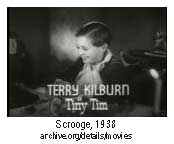Excerpts from Reviewing the Movies, Chapter 5
“The first rule in children and film is simple: Visual sophistication is the standard by which most young children evaluate what they watch. If a film is fresh and technically sophisticated, kids are more likely to find it entertaining. Practically speaking, this means that it may be hard to get your little ones to warm up immediately to Darby O”Gill and the Little People (1959) and Shane (1953). Great as these films are, they are old; and to the modern child, old is not a good thing. Most parents know this from humbling personal experience.“ tinyTim.jpg “A child does not discriminate as an adult does between the play and the reality behind the play. The play is the reality. A child will, for example, have difficulty watching two versions of a particular film or two actors playing a certain role. At Christmas time, most adults still carry the childhood tendency to watch either the Reginald Owens Christmas Carol or the Alistair Sim Christmas Carol, not both. There can be only one Heidi – Shirley Temple.
From this we can conclude what many psychologists have concluded: Children are far less able to witness screen violence at a distance than are adults. The carryover into the real world is much more pronounced. Think of a child’s tendency to play out Batman punches and Bruce Lee kicks after viewing a movie with that kind of violence.

A child assumes a basic integrity and truthfulness in the message of a film. Why should a film lie when it looks so real and entertains so well? Beyond this, why should one film be truthful or worthwhile while another, that looks just the same, not be? The child sees the earlier Disney films in which the heroes pit good versus evil in a head-on fashion. “These deductions become assumptions when that child sees future Disney films.”
Think about the shift in role models in the newer Disney films (The Mermaid) compared to the older films such as Snow White. What change do we see? Children assume that which they see in the movies is true. In Pocahontas, John Smith is portrayed as a handsome, heroic hero. Actually he was a short, red-faced mercenary with a talent for enlarging stories.
“We have to remember how Paul used the words of Greek poets in Acts 17 as a method of creating a point of contact for the presentation of the Gospel to those gathered at Mars Hill. Paul was translating into the language of that particular culture.” Now we may not be “saving” our children in the evangelistic sense that Paul intended. But we will be giving the children the tools that they need.
